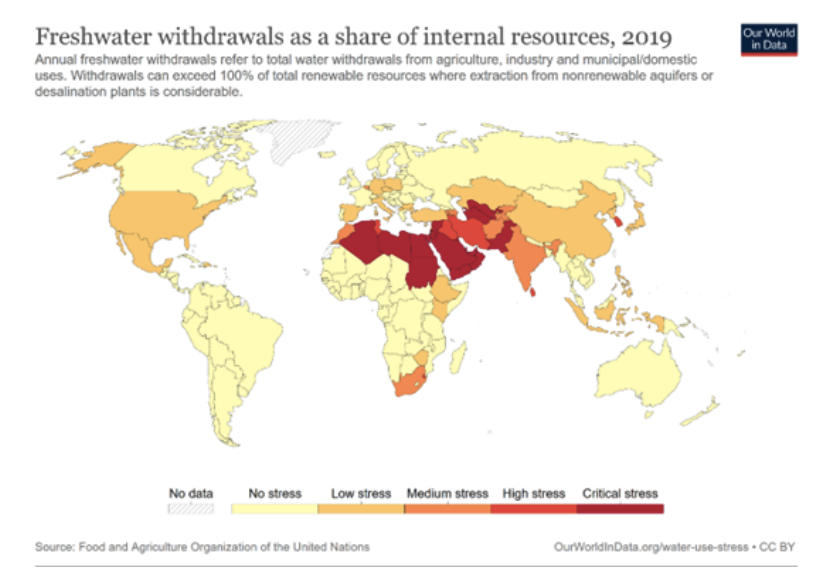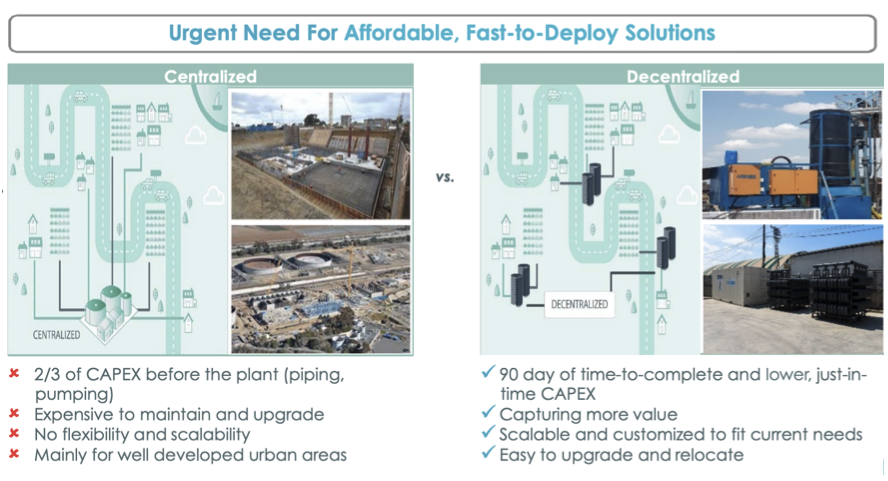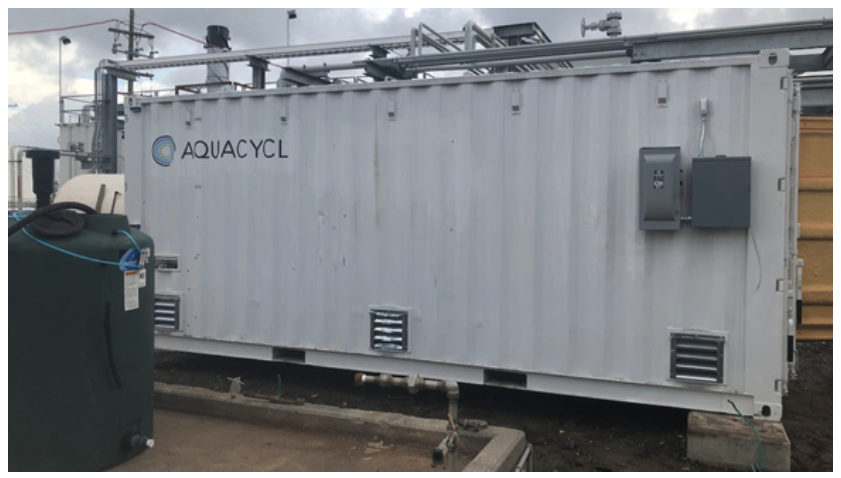4Revsピックアップ
2023年8月16日
自然の廃水処理: 小さな生物が世界の水安全保障を改善する

概要
世界では4人に3人が何らかの形で水の不安を経験している。世界で最も水不足に陥っている国々でさえ、自然の水生態系(河川、湖沼、池、地下水など)から水が引き抜かれ続けている一方で、廃水の大部分は未処理のまま水生態系に流入している。
その結果、良質な水へのアクセスが不公平になっている。特に、ほとんどのシナリオにおいて、廃水を処理するよりもきれいな水を購入する方が安いからである。残念なことに、代表的な廃水処理方法のほとんどは、エネルギー使用量が多く高コストである。そのため、規模を拡大することは不可能である。
廃水を処理することは、世界中の水不足を解決するための重要な道筋である。小さな生物(バクテリア、藻類、ミミズなど)を使って廃水を処理することは、特に溶存有機物が多い場合には、実行可能な選択肢となる。このアプローチは、19世紀からの「従来の」方法からヒントを得て、現在では収益性の高い供給モデルと組み合わせている。
廃水を処理するためのこのような自然のアプローチには、処理コストとそれに伴う二酸化炭素排出量を少なくとも3分の1削減できる可能性がある(無機または化学ベースのアプローチと比較した場合)。しかし、ほとんどの使用例は飲食部門からの廃水を対象としており、特に世界の南半球では、取り組むべき機会のギャップがある。
本文はここから
SDGs Chart

注目ポイント
問題:世界の水生態系における安全保障の欠如
・世界では現在、4人に3人が何らかの形で水不足に陥っている。
・世界における水不足の3つの主な課題:(a) 非効率な水利用インフラ、(b) 不適切な廃水管理、(c)自然の水生態系の健全性。
背景: 水の不安を解決するためのアプローチの優先順位付け
・IoTを活用した遠隔監視ソリューションの利用・導入により、水生態系のデータと透明性が向上している。
・多くの廃水処理ソリューションは、導入コストが高く、複雑である。
・コストと炭素のギャップに対処し、サービスとしての廃水処理を可能にする。
解決策: 実行可能な廃水処理を可能にする小さな生物の利用
・廃水の生物学的処理 – 19世紀から続くアプローチ
・成功したビジネス・モデルは、生物を利用して持続可能な(そして収益性の高い)廃水処理を実現する可能性を示している。
成功したビジネスモデルは、生物を利用した持続可能な(そして収益性の高い)
・ほとんどの解決策は、飲食部門の廃水処理に焦点を当てている。農業廃水を対象とした商業的ソリューションの存在感は低い。
小さな生物を廃水処理に利用することの影響
・廃水処理コストとそれに伴う二酸化炭素排出量を、少なくとも3分の1に削減できる。
・水不足が深刻な地域にとって、自然の廃水処理は利用可能な水の質を向上させる。
廃水処理と水の安全保障に関するシステムの視点
・利用可能な解決策を、環境的にも経済的にも実行可能なものにすることが重要である。
・水不足を解決するために、ソリューションの創造者は画一的なアプローチを避ける必要がある。
事例の概要
2023年に実施された世界水セキュリティ・アセスメントによると、現在、4人に3人が飲料水、衛生設備、衛生(しばしばWASHと呼ばれる)の面で、何らかの形で水の不安を経験している。水へのアクセス不足と水質の枯渇は、世界的な水不足に拍車をかける重大な傾向であり、人間の健康、水生生物、食糧安全保障、経済成長に悪影響を及ぼす。

Freshwater withdrawals as a share of internal resources, 2019. [Source: Our World In Data]
水不足という状況の中で、農業、工業、自治体(公共および家庭)の需要を満たすために、水の取水と使用は安全なレベルを超え続けている。その結果、アフリカ、中東、アジアの国々が最も水不足と水不足に陥っている。効果的な水管理のための再現可能でスケーラブルな解決策がなければ、世界の水不足はますます深刻化し、紛争の火種となるだろう。
世界の水生態系における安全保障の欠如
地表水(河川、湖沼、池など)、地下水、海洋(海、海域)は、自然の水生態系を形成している。人間が作り出したインフラ(貯水池、ダム、パイプなど)は、農業、工業、自治体のニーズを満たすために、自然の水生態系と相互作用している。
最新の地理的評価と水に関連するSDGsに基づき、世界的に水不足が抱える3つの主な課題を以下に示す:
1. 非効率な水利用インフラ
インフラ(処理プラント、パイプ、下水道システム)全体で水が失われることにより、水への公平なアクセスが減少している。この無収水量(NRW)は、人間のインフラ内で利用可能な水の3分の1を占めている。同時に、水利用効率は過去10年間で約12%しか上昇していない。
2. 不適切な廃水管理
水が使用されると、(無機および有機廃棄物を含む)廃水が副産物のひとつとなる。2017年現在、世界の廃水の80%が処理されることなく自然の水生態系に再導入されており、そのほぼ半分を自治体の廃水が占めている。この傾向が続いているのは、廃水を処理するよりもきれいな水を手に入れた方が安上がりな場合が多いからであり、一方で、実行可能な廃水規制がないため、水利使用者はこの問題を無視しがちである。
3. 自然水生態系の健全性
自然に存在するさまざまな水域とは別に、流域は自然の水生態系の不可欠な一部である。一方では、水の損失が水の過剰採取につながり、未処理の廃水が自然の生態系に再び流入することで水質が低下する。同時に、予測不可能な降水パターンが出現する一方で、森林伐採によって流域の面積は世界的に減少している。
このような世界的な水不足の課題の1つまたは複数に対する解決策のコストと複雑さによって、その普及と採用が決まるが、具体的な数値や数字は地域や国によって異なる可能性がある。
水の不安を解決するための課題とアプローチの優先順位付け
水の不安を解決するための主なステークホルダーは、(a)水の利用者(人々、組織、都市)、 (b)ソリューションの構築者(イノベーター、企業、政府)である。これらの主体は、水の生態系(自然と人間が作り出したもの)の中で役割を果たし、すべての人に清潔で公平な水へのアクセスを確保する。
大まかに言えば、水の不安定性に対処するためのアプローチは、これら3つのカテゴリーのいずれかに分類される:
1、情報 例えば、透明性の向上や水質の正確なモニタリングなどである。
2、予防 例えば、あらゆるレベルにおける水質汚濁防止法の施行。
3、投資 例えば、解決策への資金提供や水処理へのインセンティブ付与など。

シンプルで低コストのソリューションは、多くの場合、スケールアップが容易であり、長期的に持続可能である。例えば、IoTを活用した遠隔監視ソリューションの利用や導入は、水生態系におけるデータと透明性を高めている。これらのモニタリング・ソリューションは、経済的に実行可能なOPEX(運用経費)モデルで提供されることが多く、利害関係者にとって導入が容易である。
それに比べ、廃水処理ソリューションの多くは導入コストが高く、複雑である。イオン交換、膜ろ過、酸化などの無機的アプローチは、コストとカーボンフットプリントが高く、規模が大きくなると採算がとれなくなる。現在のところ、こうしたソリューションが最も高い市場シェアを占めている。このコストと炭素のギャップに対処するため、つまり廃水処理を低コストでスケーラブルにするため、世界中のイノベーターや企業は、生物(微生物、藻類、ミミズなど)を利用して、サービスとしての廃水処理を可能にしている。
小さな生物を使って実行可能な廃水処理を可能にする
無機的・化学的な廃水処理は、集中処理されることが多く、エネルギー集約的でコストがかかる。廃水の生物学的処理は、19世紀にさかのぼるアプローチであるが、こうしたギャップを解決できる可能性がある。ほとんどの生物学的処理アプローチは、微生物(バクテリアなど)の利用を伴うが、これは廃水で増殖する他の種類の小さな生物にまで広がっている。
ここでは、廃水処理に生物学的アプローチを用いたいくつかの解決策を、その範囲と採用規模の観点から紹介する:


Biopipe社は、従来の集中型廃水インフラと比較して、灌漑や二次利用用途で再利用するために生活廃水を処理する分散型システムを提案している。[出典:バイオパイプ]
排水処理に生物を利用する)商業的に実行可能なソリューションに関する研究から、いくつかの連動した傾向が浮かび上がってきた:
1. 分散型で、エネルギー効率が高く、設計上低コストのため、無機・化学ベースの廃水処理の欠点に対処できる。特に、分散型でモジュール化されているため、廃水処理中の運用面で有利である。
a. 例えば、運転開始時に80%の能力を必要とする他のシステムとは異なり、Biopipeはわずか10%の能力で運転が可能である。
2. 商業的に実現可能なソリューションのほとんどは、世界の北半球で利用・運用されている。これは、イノベーターや企業が取り組むべき地理的ギャップである。
a. 例えば、バイオギル社やバイオパイプ社は、中東、フィリピン、タイなどのグローバル・サウス地域でプロジェクトを実施している。
3. ほとんどのソリューションは飲食部門の廃水処理に焦点を当てており、農業廃水を対象とした商業的ソリューションの存在感は薄い。地理的な観点から見ると、南半球には北半球よりも多くの農業国があり、農業廃水は最も監視されていない。
a. 例えば、Aquacyclは、自然界に存在するバクテリアと電気を組み合わせ、多様な種類の廃水に対応している: 例えば、アクアサイクルは、天然由来のバクテリアと電気を組み合わせ、飲食部門、糞尿管理(畜産)、分散型衛生(自治体)、炭化水素除去(液体貯蔵産業)といった多様な廃水に対応している。
4. 運転経費(OPEX)モデルを提供するソリューションは、多額の先行投資を必要とするものよりも迅速にスケールアップする。セクター別の観点から見ると、OPEXモデルは農業セクター、特にグローバル・サウスでは珍しい。
a. Biofiltro、Cambrian Innovation、Aquacyclは、OPEXモデルを通じて、ターンキー設置、運営、メンテナンスを提供している。収益は廃水処理量と効果に対して発生する。

Vopak社(タンク貯蔵会社)におけるAquacyclのオンサイト廃水処理は、小さな設置面積で、温室効果ガス排出量を50%削減し、すべての監視対象化合物の許可遵守を実証することができた。[出典:ウォーター・テクノロジー・オンライン]
成功したビジネスモデルは、持続可能な(そして収益性の高い)廃水処理に生物を利用する可能性を示している。技術革新は、廃水のより多様で状況に応じた利用ケースに対応し続ける必要がある一方、市場参入戦略と収益モデルの反復が、世界で最も水不足に悩む国々でこのようなソリューションの採用を促進するだろう。
インパクト・ステートメント
未処理の廃水問題に対処することは、世界で最も水不足に悩む地域の水の安全保障を改善する上で極めて重要である。現在、未処理の廃水の大部分(約80%)が自然の水生態系に入り込み、水へのアクセスと水質を低下させている。
廃水処理における化学的・無機的アプローチのほとんどは、高価でエネルギー集約的である。そして現在、このような解決策は、持続可能で経済的に実行可能な廃水処理アプローチよりも高い市場シェアを占めている。
廃水、特に溶存有機廃棄物の濃度が高い廃水(飲食部門や自治体など)を処理するために小さな生物を利用することは、処理される廃水の割合を増やすための実行可能な選択肢である。また、水利用者(人々、産業、都市)が二酸化炭素排出量を削減しながらコストを削減するのにも役立つ。
自然廃水処理でコストとカーボンフットプリントを削減
小さな生物を使って廃水を処理する商業化された例(自然なアプローチ)に基づくと、廃水処理コストとそれに伴う二酸化炭素排出量を少なくとも3分の1削減することができる。これは、分散型廃水処理の価値提案を強化し、最終的には世界中の水の社会経済的価値の向上に貢献する。
廃水処理による水生態系の乱開発抑制
廃水を処理し、処理した水を資源として利用することを選択することで、生態系からの取水量が減少する。同時に、未処理の水が再び水生態系に流入する量も減り、利用可能な水の質の向上に貢献する。これらの成果は、水ストレスが最も高い地域で最も重要である。
ビジネスと運営モデルの革新で、廃水処理率を向上
廃水処理の最大の課題のひとつは、産業界が廃水処理を行うには、きれいな水を購入するよりもコストがかかる場合が多いということだ。小さな生物を使った処理の商業化された例は、水の利用者(人々、産業、都市)にとって強い価値提案を持っている: (a)うまくスケールしているモデルは、高額な先行投資の障壁を減らすためにOPEXモデルに基づいている。
以下は、廃水処理に小さな生物を利用することによって、(影響の大きいものから小さいものへと)取り組まれているSDGsである:
SDG6:「すべての人が水と衛生設備を利用できるようにし、持続可能な管理を確保する」。
SDG12:”持続可能な消費と生産パターンの確保”
SDG13:「排出量を規制し、再生可能エネルギーの開発を促進することにより、気候変動とその影響と闘うための緊急行動をとる。
SDG9:「強靭なインフラを構築し、包摂的で持続可能な産業化を推進し、イノベーションを促進する
SDG10:”国内および国家間の所得格差を縮小する”
SDG 3: “あらゆる年齢層のすべての人々の健康的な生活を確保し、幸福を促進する”
SDG14: “持続可能な開発のために、海、海洋、および海洋資源を保全し、持続可能な形で利用する”
システムの視点
世界の4人に3人が何らかの形で水の不安を経験している。きれいな水へのアクセスは不平等である。そのため、さまざまな利害関係者(水の利用者と解決策の創造者)が、状況に応じたさまざまなアプローチや解決策を統合しながら、集団で行動する必要がある。
廃水管理の文脈では、主な課題はエネルギー効率とプロセスに関連するコストであった。したがって、利用可能なソリューションをより環境的・経済的に実行可能なものにすることは、ほとんどの廃水が発生地で処理される未来を実現するための重要な道筋である。
廃水処理には多様なアプローチがある。極小の生物を廃水処理に利用する場合、商業化されている例は、他の方法(化学薬品や無機物質の使用など)よりも持続可能で経済的な利点が明確である。とはいえ、廃水管理のワンストップ・ソリューションではない。例えば、廃水に化学廃棄物や金属不純物が多量に含まれている場合には、単独の選択肢としては適さない。
廃水に対する一面的なアプローチの限界は、小さな生物を利用するソリューションの焦点で明らかになる。そのほとんどが飲食部門に焦点を当てており、産業廃水の発生源トップ3には入っていない[エネルギー部門:85%、製造部門(場合によっては飲食部門も含む):12%、鉱業部門:2%]。現在、未処理廃水を削減する最大のチャンスは、最も監視が行き届かない農業であり、次いで自治体、工業の順となっている。
総合的な対策を実施し、廃水を大規模に資源化するためには、様々なアプローチを組み合わせることが重要である。ソリューション・クリエーター(イノベーター、企業、政府)は、このことを実際に認識し、この課題を解決するための画一的なアプローチを避ける必要がある。
また、廃水処理は、水の生態系における他の課題、そしてより広くは気候変動と関連している課題である。例えば、自然の水生態系を回復させる自然ベースの解決策は、現在の気候変動の影響と気象パターンの変化とのバランスをとるために不可欠である。
誰もが公平に水にアクセスできる世界を設計するためには、組織やシステムの変更に加えて、社会として水の価値をよりよく理解する必要がある。現在、きれいな水は過小評価されており、水に公正な価値をもたらし、住む場所や収入に関係なく水の安全保障を確保するためには、あらゆるレベルでの行動変容が鍵となる。
関連リンク
バイオギル(アジア太平洋地域)
・ウェブサイト:https://biogill.com/
・経営チーム ジョン・ウェスト(創設者)
バイオパイプ(グローバル)
・ウェブサイト:https://www.biopipe.co
・チーム: https://www.biopipe.co/about-us
バイオフィルトロ(グローバル)
・ウェブサイト:https://biofiltro.com/
・経営チーム:https://biofiltro.com/who-we-are/
カンブリアン・イノベーション(北米)
・ウェブサイト:https://www.cambrianinnovation.com/
・経営チーム マシュー・シルバー(創業者兼CEO)
GWT(北米)
・ウェブサイト:https://algae.com
・経営陣: https://algae.com/about
Aquacycl(北米)
・ウェブサイト:https://www.aquacycl.com
・経営チーム:https://www.aquacycl.com/company/
***
人類は、地球上の生命が繁栄し続けるために克服しなければならない4つの必須生存課題(4Revs)、すなわちボトルネックに直面しています: 食料、水、資源、気候変動・エネルギーです(詳細は下記)。この4つの領域は、革命的なイノベーションを必要とすると同時に、新しい機会の宝庫でもあります。
4Revsは、人類がこの4つの分野を解決するためのユニークな共創型エコシステムです。
4Revsは、2020年から2050年にかけての一世代で、人類がこれら4つの生存課題を解決することを目指す、ユニークな共創エコシステムです。
***
※原文(英語)を自動翻訳したものです。詳細に関しては事務局までお問い合わせください。
お問い合わせはこちらから
https://4revs.net/contact/
Aug 16, 2023
Natural Wastewater Treatment: Using Organisms to Improve Global Water Security
#water#water-management#water-security
Abstract
Three out of four people in the world experience some form of water insecurity. Even in the most water-stressed countries in the world, water continues to be withdrawn from natural water ecosystems (rivers, lakes, ponds, groundwater, etc.), while a vast majority of wastewater is untreated – and re-enters water ecosystems in that state.
As a result, there is inequitable access to good quality water – particularly because it is cheaper to purchase clean water than treat wastewater in most scenarios. Unfortunately, most of the leading wastewater treatment approaches are high-cost with high energy use. This makes them unviable at scale.
Treating wastewater is a critical pathway to resolving water insecurity around the world. Using tiny living organisms (bacteria, algae, earthworms, etc.) to treat wastewater – especially with high amounts of dissolved organic matter – is a viable alternative. This approach takes inspiration from ‘conventional’ methods from the 19th century and now combines them with profitable delivery models.
Such natural approaches to treating wastewater have the potential to reduce treatment costs and associated carbon footprint by at least one-third (when compared to inorganic or chemical-based approaches). However, most use cases focus on wastewater from the F&B sector and there is an opportunity gap to be addressed, particularly in the global South.
Full text starts here
Sustainable Development Goals Chart

Main Highlights
Problem: Lack of security in water ecosystems around the world
● Globally, 3 out of 4 people currently experience some form of water insecurity
● Three main challenges of water insecurity, globally: (a) inefficient water-use
infrastructure, (b) improper wastewater management, and (c) Health of natural water ecosystems
Context: Prioritizing approaches to resolving water insecurity
● Use and adoption of IoT-enabled remote monitoring solutions, is increasing data and transparency in water ecosystems
● Many wastewater treatment solutions are expensive and complex to adopt – high costs and carbon footprints – making them unviable at scale
● Address cost-carbon gap – to enable wastewater treatment as a service
Solution: Using tiny living organisms to enable viable wastewater treatment
● Biological treatment of wastewater – an approach that dates to the 19th-century
● Successful business models indicate the potential for using living organisms to
sustainably (and profitably)
● Most solutions focus on wastewater treatment for the F&B sector, while commercial
solutions targeted to agricultural wastewater are under-represented
Impact of using tiny living organisms for wastewater treatment
● Reduce wastewater treatment costs and associated carbon footprint by a factor of at least one-third
● For regions with highest water stress, natural wastewater treatment improves the quality of available water
A Systems Perspective on wastewater treatment and water security
● Making available solutions more environmentally and economically viable is critical
● Solution creators need to avoid a one-size-fits-all approach to resolve water insecurity
Case overview
According to a Global Water Security Assessment done in 2023, 3 out of 4 people currently experience some form of water insecurity; in the contexts of drinking water, sanitation, and hygiene (often referred to as WASH). Lack of access to water and depleting water quality are the critical trends driving global water insecurity, which has negative outcomes for human health, aquatic life, food security, and economic growth.

Freshwater withdrawals as a share of internal resources, 2019. [Source: Our World In Data]
Within the context of water insecurity, withdrawal and use of water continue to exceed safe levels to meet agricultural, industrial, and municipal (public and domestic) needs. As a result, countries in Africa, the Middle East, and Asia are most water-stressed and water-insecure. Without replicable and scalable solutions for effective water management, global water insecurity will continue to deepen and fuel conflicts.
Lack of security in water ecosystems around the world
Surface water (rivers, lakes, ponds, etc.), groundwater, and marine bodies (oceans and seas) form the natural water ecosystems. Human-made infrastructure (reservoirs, dams, pipes, etc.) interacts with the natural water ecosystems to meet agricultural, industrial, and municipal needs.
Based on the most recent geographical assessments and water-related SDGs, here are the three main challenges of water insecurity, globally:
1. Inefficient water-use infrastructure
The loss of water across the infrastructure (treatment plants, pipes, and sewer systems) is reducing equitable access to water. This non-revenue water (NRW) accounts for one-third of all available water for use within the human infrastructure. At the same time, water-use efficiency increased by just about 12% in the last decade.
2. Improper wastewater management
Once water is used, wastewater (containing inorganic and organic waste) is one of the by-products. As of 2017, 80% of global wastewater re-entered natural water ecosystems without being treated, with municipal wastewater accounting for almost half. This trend continues because it is often cheaper to get clean water than treat wastewater, while the lack of actionable wastewater regulations makes it easy for water users to ignore this issue.
3. Health of natural water ecosystems
Apart from the different naturally occurring water bodies, watersheds are an integral part of the natural water ecosystem. On one side, water loss leads to over-extraction of water, and untreated wastewater re-entering natural ecosystems reduces water quality. At the same time, the global cover of watersheds is declining due to deforestation while unpredictable patterns of precipitation emerge.
The cost and complexity of solutions to one or more of these global water insecurity challenges determine their widespread use and adoption, while specific numbers and figures may vary across different regions and countries.
Prioritizing challenges and approaches to resolving water insecurity
The primary stakeholders in resolving water insecurity are (a) water users (people, organizations, cities), and (b) solution-builders (innovators, companies, governments). These entities play a role within the water ecosystem (natural and human-made) to ensure clean and equitable access to water for all.
Broadly, approaches to address water insecurity fall under one of these three categories:
- Information. For instance, better transparency and accurate monitoring of water quality
- Prevention. For instance, enforcement of water pollution laws at all levels
- Investments. For instance, financing solutions and incentivizing water treatment

Solutions that are simple or low-cost are often easy to scale – and sustainable in the long run. For instance, the use and adoption of IoT-enabled remote monitoring solutions, is increasing data and transparency in water ecosystems. These monitoring solutions are often offered in economically viable OPEX (operational expenditure) models, making it easy for stakeholders to implement them.
In comparison, many wastewater treatment solutions are expensive and complex to adopt. Inorganic approaches, such as ion exchange, membrane filtration, and oxidation, have high costs and carbon footprints, making them unviable at scale. Such solutions have the highest market share, currently. To address this cost-carbon gap – to make wastewater treatment low-cost and scalable, innovators and companies around the world are using living organisms (such as microorganisms, algae, worms, etc.) to enable wastewater treatment as a service.
Using tiny living organisms to enable viable wastewater treatment
Inorganic and chemical-based wastewater treatment is often centralized, energy-intensive, and costly. The biological treatment of wastewater – an approach that dates back to the 19th century – may address these gaps. Most biological treatment approaches involve the use of microorganisms (like bacteria), but this has expanded to other types of tiny living organisms that thrive on wastewater.
Here are a few solutions using the biological approach to wastewater treatment, in the context of their scope and scale of adoption:


Compared with traditional, centralized wastewater infrastructure, Biopipe presents a decentralized system that treats domestic wastewater for reuse in irrigation and secondary use applications. [Source: Biopipe]
From the research on commercially viable solutions (for using living organisms to treat the wastewater), a few interlinked trends emerge:
1. They are decentralized, energy-efficient, and low-cost by design – addressing drawbacks of inorganic and chemical-based wastewater treatment. Especially because they are decentralized and modular, they have operational advantages while treating wastewater.
a. For instance, unlike other systems, which require a starting operational capacity of 80%, Biopipe can operate at only 10% capacity
2. Most commercially viable solutions are available and operational in the global North, whereas most water-stressed countries and people are in the global South. This is a geographical gap for innovators and companies to address.
a. For instance, BioGill and Biopipe have implemented projects in Global South regions like: the Middle East, Philippines, Thailand, etc.
3. Most solutions focus on wastewater treatment for the F&B sector, while commercial solutions targeted to agricultural wastewater are under-represented. From a geographical perspective, the global South has more agrarian countries than the global North, and agricultural wastewater is the least monitored.
a. For instance, Aquacycl combines naturally occurring bacteria and electricity to meet diverse types of wastewater: F&B sector, manure management (livestock), distributed sanitation (municipal), and hydrocarbon removal (liquid storage industry).
4. Solutions that provide an operational expenditure (OPEX) model scale quicker than the ones that require large upfront investments. From a sectoral perspective, OPEX models are uncommon in the agricultural sector, particularly in the global South.
a. Biofiltro, Cambrian Innovation, and Aquacycl offer turnkey installation, operation, and maintenance through OPEX model, where revenue is generated against the volume and effectiveness of wastewater treated

Aquacycl’s onsite wastewater treatment at Vopak (tank storage company) was able to demonstrate permit compliance of all monitored compounds in a small footprint, with 50% lower greenhouse gas emissions. [Source: Water Technology Online]
Successful business models indicate the potential for using living organisms to sustainably (and profitably) treat wastewater. Innovations need to continue to address more diverse, contextual use cases of wastewater, while iterations in go-to-market strategies and revenue models will drive the adoption of such solutions in the most water-insecure countries in the world.
Impact Statement
Addressing the untreated wastewater challenge is critical to improving water security in the most water-stressed regions of the world. At present, most of the untreated wastewater (~80%) enters the natural water ecosystems – reducing access to water and the quality of water.
Most chemical and inorganic approaches to wastewater treatment are expensive and energy intensive. And currently, such solutions have a higher market share than sustainable and economically viable approaches to wastewater treatment.
Using tiny living organisms to treat wastewater – especially those with high concentrations of dissolved organic waste (such as from the F&B sector, municipalities, etc.) – is a viable alternative to increase the proportion of wastewater that gets treated. Also, it helps water users (people, industries, and cities) to reduce costs while reducing their carbon footprint.
Natural wastewater treatment reduces costs and carbon footprint
Based on commercialized examples of using tiny living organisms to treat wastewater (natural approach), they reduce wastewater treatment costs and associated carbon footprint by a factor of at least one-third. This strengthens the value proposition for decentralized wastewater treatment and eventually helps improve the socio-economic value of water around the world.
Wastewater treatment reduces overexploitation of water ecosystems
By choosing to treat wastewater and use the treated water as a resource, the water withdrawals from the ecosystem reduce. At the same time, this reduces the amount of untreated water re-entering the water ecosystems, helping improve the quality of available water. Both these outcomes are of the highest significance in regions with the highest water stress.
Business and operational model innovations increase % of wastewater treated
One of the biggest challenges to wastewater treatment is that it’s often more expensive for industries to get their wastewater treated than just purchasing clean water. The commercialized examples of treatment using tiny living organisms have strong value propositions for water users (people, industries, and cities): (a) models that are scaling well bank on an OPEX model to reduce the barrier of high upfront investments, (b) they unlock financial savings for users while enabling them to achieve environmental goals.
Here are the SDGs being addressed (from most impact to least impact) by using tiny living organisms for treating wastewater:
- SDG 6: “Ensure availability and sustainable management of water and sanitation for all”
- SDG 12: “Ensure sustainable consumption and production patterns”
- SDG 13: “Take urgent action to combat climate change and its impacts by regulatingemissions and promoting developments in renewable energy”
- SDG 9: “Build resilient infrastructure, promote inclusive and sustainable industrialization,and foster innovation”
- SDG 10: “Reduce income inequality within and among countries”
- SDG 3: “Ensure healthy lives and promote well-being for all at all ages”
- SDG 14: “Conserve and sustainably use the oceans, seas, and marine resources for sustainable development”
Systems Perspective
Three out of four people in the world are experiencing some form of water insecurity. Access to clean water is inequitable. This requires collective action from different stakeholders (water users and solution creators) along with the integration of various context-relevant approaches and solutions.
In the context of wastewater management, the primary challenges have been energy efficiency and the costs associated with the process. Therefore, making available solutions more environmentally and economically viable is a critical pathway to enable a future where most wastewater gets treated, at the place of its origin.
Within wastewater treatment, there are diverse approaches. Coming to using tiny living organisms for treating wastewater, the commercialized examples have clear sustainable and economic advantages over other methods (such as using chemicals or inorganic materials). That said, it’s not the one-stop solution to wastewater management. For instance, it is not a suitable standalone choice when the wastewater contains high amounts of chemical waste or metallic impurities.
The limitation of a one-dimensional approach to wastewater becomes apparent in the focus of solutions that use tiny living organisms. Most of them focus on the F&B sector, which is not among the top 3 generators of industrial wastewater [energy – 85%; manufacturing (which includes F&B in some cases) – 12%, and mining – 2%]. At present, the biggest opportunity to reduce untreated wastewater is in agriculture because it is the least monitored, followed by municipalities and industries.
For an implementation to be holistic, and to turn wastewater into a resource at scale, a combination of approaches is important. Solution creators (innovators, companies, and governments) need to recognize this in practice and avoid a one-size-fits-all approach to resolving this challenge.
Also, wastewater treatment is a challenge that is connected to other challenges in the water ecosystem and more broadly, climate change. For instance, nature-based solutions to restore natural water ecosystems are critical to balance the current effects of climate change and shifting weather patterns.
To design a world where everyone has equitable access to water, in addition to changes to organizations and systems, as a society the value of water needs to be better understood. Currently, clean water is undervalued, and behavior change at all levels is key to bringing a fair value to water, and ensuring water security regardless of where someone lives or how much money they make.
Links
BioGill (Asia-Pacific)
・ Website: https://biogill.com/
・Management Team: John West (Founder)
Biopipe (Global)
・Website: https://www.biopipe.co
・ Team: https://www.biopipe.co/about-us
Biofiltro (Global)
・ Website: https://biofiltro.com/
・ Management Team: https://biofiltro.com/who-we-are/
Cambrian Innovation (North America)
・ Website: https://www.cambrianinnovation.com/
・ Management Team: Matthew Silver (Founder & CEO)
GWT (North America)
・ Website: https://algae.com
・ Management Team: https://algae.com/about
Aquacycl (North America)
・Website: https://www.aquacycl.com
・Management Team: https://www.aquacycl.com/company/
***
Humanity is facing four essential survival challenges (4Revs) – or bottlenecks – which we must overcome to enable the continued flourishing of life on Earth: Food, water, resources, and climate change/energy (details below). These four areas will require revolutionary innovation and, at the same time, provide a treasure trove of new opportunities.
4Revs is a unique, co-creative ecosystem
that aims to help humanity solve these four survival challenges in one generation – between 2020-2050.
Thank you for partnering with us.
Contact
https://4revs.net/contact/
最新のピックアップ
-
2024年3月8日
Mar 8, 2024
lithium battery; energy transition; recycling; closed loop

-
2024年3月6日
Mar 6, 2024
Tomato Jos: Investment & Impact into Nigeria’s Tomato Industry

-
2024年3月4日
Mar 4, 2024
ネイチャー・ポジティブに資する 投資は、世界全体のわずか 3%に過ぎない
Only 3 per cent of global investments are nature- positive

-
2024年2月3日
Feb 3, 2024
Towards sustainable regenerative food systems

-
2024年1月4日
Jan 4, 2024
Climate adaptation – 150 options for water in agriculture

